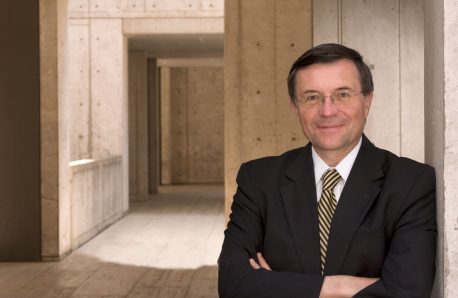
May 17, 2022
LA JOLLA—Salk Institute Professor Terrence Sejnowski has been awarded the 2022 Gruber Neuroscience Prize by the Gruber Foundation for his “pioneering contributions to computational and theoretical neuroscience.” He shares the $500,000 award with Larry Abbott of Columbia University, Emery Neal Brown of the Massachusetts Institute of Technology and Massachusetts General Hospital, and Haim Sompolinsky of the Hebrew University of Jerusalem and Harvard University.

“Terry is a trailblazer who has revolutionized the field of computational neuroscience,” says Salk President Rusty Gage. “He has created novel computational models to better understand brain function, which may aid researchers in developing new therapies for neurological disorders.”
Sejnowski, who is head of Salk’s Computational Neurobiology Laboratory and a distinguished professor at UC San Diego, has helped shape fields of neuroeconomics, neuroanatomy, neurophysiology, psychology and artificial intelligence. In 1985, while at Johns Hopkins University, he collaborated with computer scientist Geoffrey Hinton to invent the Boltzmann machine, the first algorithm to solve the problem of learning in multilayered neural networks. It remains the most biologically plausible of all subsequent learning algorithms for artificial neural networks.
Soon after announcing the Boltzmann machine, Sejnowski created NETtalk, a computer program that, like the human brain, was able to learn how to turn written text into speech. Not only was this an astounding engineering accomplishment but it also marked a major cultural milestone as it raised new challenges for philosophy, linguistics and cognitive science.
Sejnowski also helped develop the first unsupervised learning algorithm for independent component analysis, which is now a mainstay in brain imaging. He has also shown that sleep spindles (brain wave patterns during nonrapid eye movement sleep) are not synchronous across the cortex, as was previously believed, but instead create circular traveling waves.
“I am honored to receive the Gruber Prize as a recognition of my work,” says Sejnowski, holder of the Francis Crick Chair at Salk. “My hope is that this research will deepen our understanding of how the brain learns and of how memory is affected in disorders such as Alzheimer’s disease.”
Sejnowski has received numerous other awards, including the Institute of Electrical and Electronics Engineers Frank Rosenblatt Award, Neural Network Pioneer Award, Hebb Prize and Wright Prize. He is a member of the National Academy of Sciences, National Academy of Medicine, National Academy of Engineering, and National Academy of Inventors.
Office of Communications
Tel: (858) 453-4100
press@salk.edu
Unlocking the secrets of life itself is the driving force behind the Salk Institute. Our team of world-class, award-winning scientists pushes the boundaries of knowledge in areas such as neuroscience, cancer research, aging, immunobiology, plant biology, computational biology and more. Founded by Jonas Salk, developer of the first safe and effective polio vaccine, the Institute is an independent, nonprofit research organization and architectural landmark: small by choice, intimate by nature, and fearless in the face of any challenge.